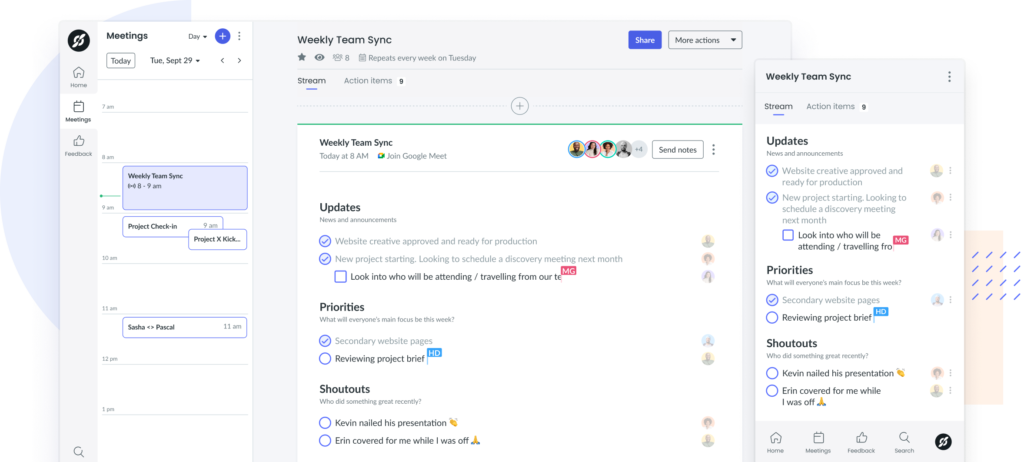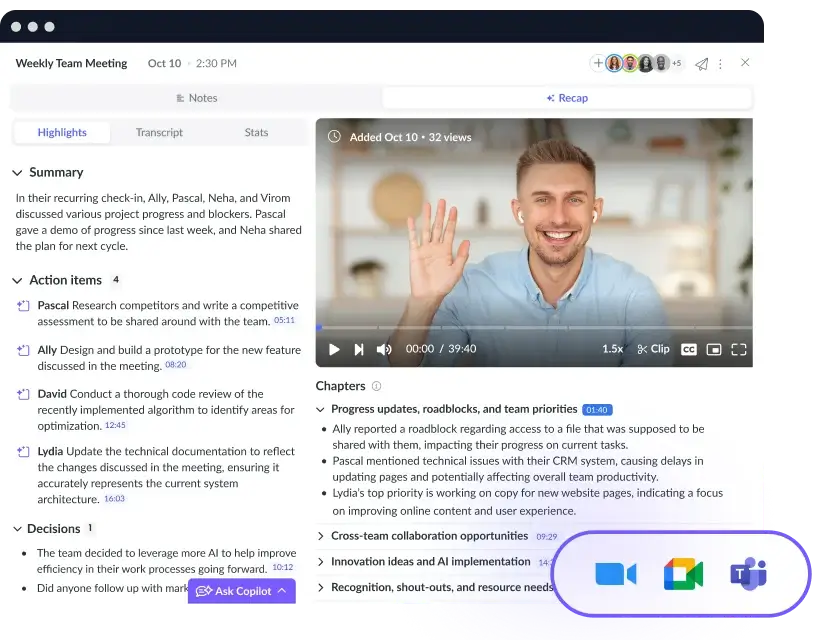How to Run an Efficient Committee Meeting: 10 Key Steps
Learn how to run an effective committee meeting in 10 simple steps to have better discussions and collaboration from all members.
Are you gearing up to run an effective committee meeting? If so, you’ve probably been scouring the internet for tips and tricks. After all, chairing a committee meeting shouldn’t be taken lightly. It requires preparation, prestige, and a certain degree of research. This is a huge responsibility, and you’ll want to make sure you’re prepared and ready to take it on with confidence.
In this article, we’ll define a committee meeting and outline 10 expert tips that will help you run your next committee meeting like a pro.
What is a committee meeting?
A committee consists of an elected or named subgroup of people within an organization that volunteer their time to organize an event or work towards a common goal. A committee meeting is designed to bring this group of people together in a planned environment to hash out a plan or collaborate until the final goal is accomplished. Once the goal is accomplished, the team will disband.
Depending on their objectives, committee meetings may function in a way that mimics meetings you’re used to, like project meetings or board meetings. Unlike more traditional business-minded meetings, committee meetings may need to follow a certain subset of rules or guidelines. These rules or guidelines may include meeting frequency, the need to provide advanced notice, voting obligations, and the importance of documenting meeting records.

Stay focused
Sending a meeting agenda in advance allows the attendees to show up better prepared and ready for discussion. Try using a collaborative tool like Fellow.

10 key steps to running a committee meeting
Ready to dive into the specifics of hosting an exceptional committee meeting that will leave attendees in awe of your skills? Keep reading to learn 10 expert tips.
- Set a clear purpose
- Keep to the agenda
- Set a time for updates
- Assign meeting roles
- Have a voting process
- Follow rules of order
- Give fair notice
- Take detailed notes
- Close the meeting with next steps
- Share the notes afterward
1 Set a clear purpose
A committee is often formed to work towards one common objective, which means each and every meeting is necessary for getting closer to achieving that goal. This committee is most likely composed of multiple stakeholders coming from various organizations. These meetings can be extremely hard to organize, and this planning becomes even more difficult if a clear purpose isn’t stated upfront. When you finally get these people from different organizations together, you’ll want to ensure you’re using your time efficiently.
2 Keep to the agenda
It’s nearly impossible to host an effective committee meeting without an agenda. Remember, no agenda, no attenda! Taking the time to create a thorough meeting agenda will ensure all committee members know what to expect from the meeting. A meeting agenda will ensure no important details are missed.
After you’ve gotten the agenda down pat, now comes the hard part! As the meeting chair or host, you’re responsible for ensuring everyone stays on track and sticks to the agenda. A great way to keep things running smoothly is to assign an amount of time to each item on the agenda. When you notice you’re running short on time, move the conversation along respectfully. Don’t be afraid to lean on your time keeper for additional support!
3 Set a time for updates
Setting aside a time for key updates during committee meetings is a crucial step to running an effective meeting. This time block can be used to do a round table with attendees. Each stakeholder with an important update can voice their piece and pass the microphone to the next member with an important update. Setting aside a 15-minute window at the beginning or end of each committee meeting will ensure there are no sidebars. Conversations will be less likely to go off track if you proactively allot an amount of time to allow everyone to share their updates.
4 Assign meeting roles
Assigning meeting roles is a great way to keep your committee meeting organized. When determining who should fill each role, start with volunteers. If you notice that the same people are always volunteering, it may be time to mix things up and choose someone that may be less likely to volunteer. When determining which roles need to be filled, start with the basics. You’ll want to make sure you have a meeting chair, a note taker, and a timekeeper.
6 Follow rules of order
Rules of order help organizations—or in this case, meeting attendees—take a democratic, fair approach to meetings. Ultimately, following these rules lets you ensure fairness for every committee member by allowing everyone to have an equal voice in every conversation.
7 Give fair notice
Providing committee members with fair notice regarding when each meeting will take place is a fundamental part of running committee meetings. Oftentimes these rules may be lenient and will refer to “reasonable notice,” but you can be more specific and assign a timeframe before each meeting for giving advance notice. It’s customary to choose the meeting dates at the beginning of each year or season and adjust as necessary.
8 Take detailed notes
This is where your note-taker will come in. Taking detailed notes or meeting minutes is crucial as the points, topics, discussions, or decisions that arise during your committee meeting will most likely be referenced at a later date. Taking detailed notes is also crucial if all members can’t be in attendance. These notes or minutes can be dispersed at the end of the meeting to members that weren’t able to attend, as well as to members that were in attendance so everyone is clear on key talking points and major action items.
As the chair, you’ll want to ensure your note taker is aware of what needs to be accounted for. Make sure to take all points, decisions, motions, actions, and parking lot items into consideration.
9 Close the meeting with next steps
Like any great meeting, committee meetings should end with next steps. It’s imperative that every committee meeting moves the group one step closer to achieving the common goal, and that can’t be done without having determined the committee’s next steps. If points were raised during the meeting that must be acted upon, make sure you take the time to assign a stakeholder to these next steps and clearly define how everyone will be moving forward. At the next committee meeting, be sure to follow up and ensure everyone has followed through on their action items.
10 Share the notes afterward
Meeting notes inform members who weren’t able to attend and remind those who were in attendance about key points, action items, or next steps. Ultimately, circulating your meeting notes after the meeting has ended is a great way to ensure everyone within the meeting committee is on the same page. This way, everyone will be up to speed and aware of what needs to get done before the next meeting.
When you leverage tools like Fellow, you’re able to host all of your meeting materials in one space–-including your meeting agenda and notes. The best part about leveraging this tool is having the ability to send out your agenda and notes with a simple click. If you choose to send the meeting notes via email, the names of all committee members will be pre-populated and you can add or remove recipients from your list before you send.
Synergy in session with Fellow
Running an effective committee meeting may seem overwhelming, but fundamentally it’s just like hosting any other meeting. All you need to do is show up prepared with a committee meeting agenda, take thorough meeting minutes, be respectful, and prioritize fairness.
With Fellow, you can host more organized and productive committee meetings. Fellow offers meeting templates for committee meetings to help you prepare. During the meeting, Fellow’s real-time collaborative notes ensure you capture all important details. After the meeting, Fellow’s automated meeting recaps and task assignments help you follow up on action items and keep everyone aligned.











